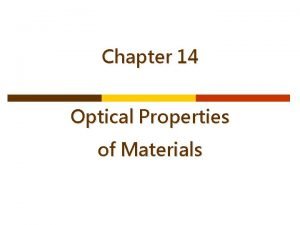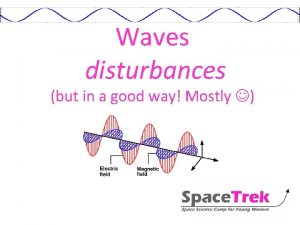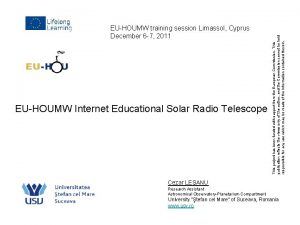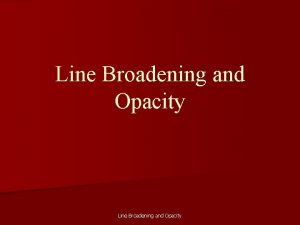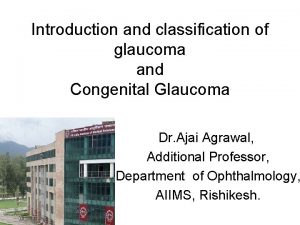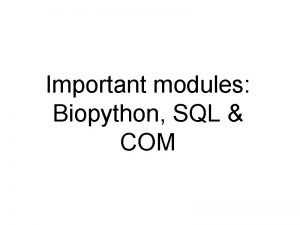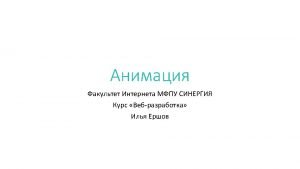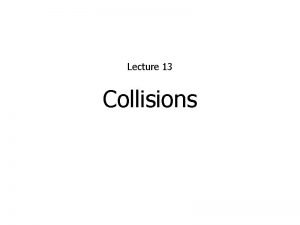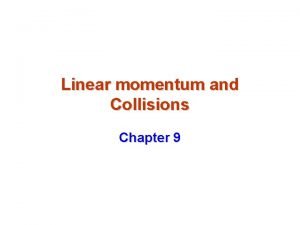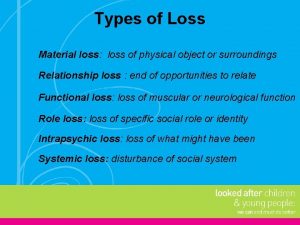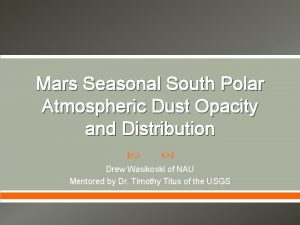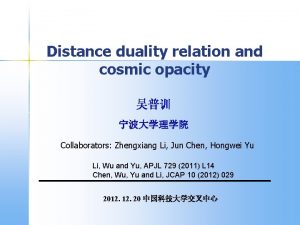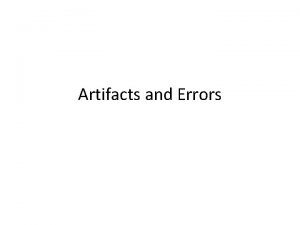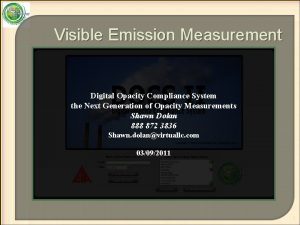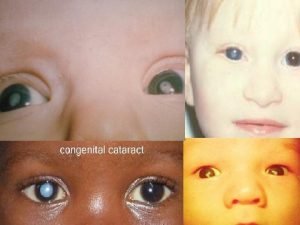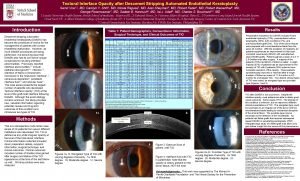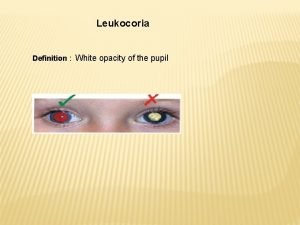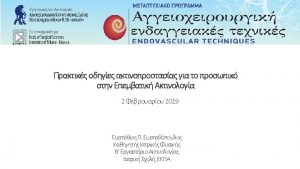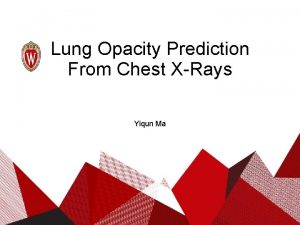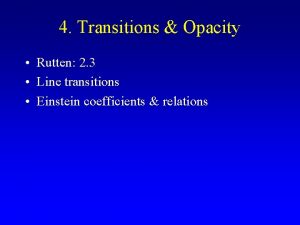Lecture 2 Energy Loss and Opacity in the










































- Slides: 42

Lecture 2 Energy Loss and Opacity in the Quark Gluon Plasma Barbara Jacak Stony Brook University January 11, 2012 1

Outline l l l TODAY ( first I’ll finish the explanation of how fluctuations help us measure the viscosity better) Partonic probes of quark gluon plasma and how to generate them Opacity of the plasma to gluons and light quarks Energy loss in p. QCD Looking inside jets in heavy ion collisions Heavy quark energy loss and diffusion 2

Fluctuations! l Nucleons move around inside the nucleus -> locations of NN scattering fluctuate -> apparent symmetry effects yielding only even harmonics not realistic /s=0. 08 l Reproduce with hydro l IF you include fluctuating initial conditions l Provides a tool to better pin down the viscosity/entropy ratio ar. Xiv: 1109. 6289 3

Higher moments more sensitive to viscosity vn( /s=0. 08)/vn(ideal) vn( /s=0. 16)/vn(ideal) ar. Xiv: 1109. 6289 l Longitudinal expansion at v ~ c Transverse at v ~ c/2 l “freezes in” shape perturbations e. g. triangular fluctuations (v 3) l Higher viscosity=more resistance 4

Fluctuations, flow and the quest for /s ar. Xiv: 1105. 3928 v 2 described by both Glauber and CGC but different values of h/s Theory calculation: Alver et al. PRC 82, 034913 v 3 described only by Glauber breaks degeneracy ar. Xiv: 1105. 3928 Theory calculation: Alver et al. PRC 82, 034913 200 Ge. V Au+Au peripheral � Glauber initial state /s = 1/4 p central 2 models with Different fluctuations, Eccentricity, r distribution Stefan Bathe for PHENIX, QM 2011 Lappi, Venugopalan, PRC 74, 054905 Drescher, Nara, PRC 76, 041903 � MC-KLN CGC initial state /s = 2/4 p 5

At the LHC ALICE v 3 v 2 Will be able to use the same technique to measure h/s 6

study plasma with radiated & “probe” particles l as a function of transverse momentum 90° is where the action is (max T, r) p. L between the two beams: midrapidity l p. T < 1. 5 Ge. V/c # scales as Npart “thermal” particles radiated from bulk medium “internal” plasma probes l p. T > 3 Ge. V/c large Etot (high p. T or M) set scale other than T(plasma) # scales as Ncoll autogenerated “external” probe describe by perturbative QCD l control probe: photons EM, not strong interaction produced in Au+Au by QCD 7 Compton scattering

Do fast quarks & gluons escape the plasma? They feel the strong interaction, so they should interact 8

Geometry again ameter =b Use Glauber model of nucleons in the nucleus calculate # of participant nucleons Npart # of binary NN collisions Ncoll 9

Opacity? Probe must feel strong interaction p-p PRL 91 (2003) 241803 p 0 Good agreement with p. QCD head-on Au+Au Ncoll = 975 94 10

colored objects lose energy, photons don’t Nuclear modification factor: VERY opaque! Lots of gluon radiation (bremsstrahlung)11

QCD: medium induces gluon bremsstrahlung I. Vitev d+Au interaction of radiated gluons with gluons in the plasma greatly enhances the amount of radiation Au+Au But even 25 Ge. V/c quarks and gluons have huge energy loss… 12

Depends on medium density l In dilute medium < Independent processes: bremsstrahlung & scattering Calculate probabilities and add them up Independent radiations follow Bethe-Heitler l In dense medium Mean free path is short: l = s/r Formation time of radiated gluon: t = w/k. T 2 Transverse momentum of radiated gluon: k. T 2=nm 2 # of collisions n=L/l, m=typical p. T transfer in 1 scattering l, m are properties of the medium, combine to q= √m 2/l l Coherence in the dense medium! Next scattering takes place faster than gluon formation Add amplitudes for all multiple scatterings In QCD this increases the energy loss! 13

Let’s get quantitative S. Bass, et al. Phys. Rev. C 79: 024901, 2009 Put 3 different energy loss schemes into common, realistic hydrodynamic calculation 14

RAA= Au. Au/pp x Ncoll Energy loss at LHC ALICE PHENIX 15

Just how opaque IS the plasma? l Use jet pairs l high p. T trigger to tag hard scattering l second particle to probe the medium l answer: VERY opaque! Central Au + Au same jet opposing jet collective flow in underlying event 16

1 -3 Ge. V/c particles 17

What happens to the lost energy? l First step: tag the jet’s energy • • qg -> q Is fragmentation of the quark into the jet of hadrons modified? Calibrate the probe energy: use QCD Compton process 18

Reconstruct jets in heavy ion collisions Requiring a narrow jet same suppression as leading hadron Hard to reconcile if eloss = splitting inside jet cone 19

Beautiful jet pairs at the LHC CMS and ATLAS have hermetic calorimeters Great for finding high energy jets! Energy loss makes them asymmetric 20

Quantify the asymmetry Similar RAA as RHIC for 100 Ge. V 250 Ge. V jets; R independent Energy loss jet asymmetry; no decorrelation, Fragm. Fn. same! 21 CMS finds excess soft particles in interjet region…

CMS analyzed missing p. T (along jet axis) Overall: high momentum particles missing, p. T balanced by soft particles Inside jet cone: high momentum particles missing, p. T is NOT balanced! Outside jet cone: The p. T is found! It lives in “extra” particles, which are soft (<2 Ge. V/c) 22

Jet results from LHC very interesting l Steep path length dependence of energy loss also suggested by PHENIX high p. T v 2 l Little modification of jet fragmentation function different at RHIC (but different jet definition & energy) l Lost energy goes to low p. T particles at large angle is dissipation slower at RHIC? Due to medium or probe? l Little modification of di-jet angular correlation appears to be similar at RHIC -> decoherence of soft jet fragments, which rapidly thermalize in the plasma? ! Jet remnants: lower E but “normal” shape l Need full, calorimetric reconstruction of jets in wide y range at RHIC to disentangle probe effects/medium effects/initial state At RHIC the radiated particles are well matched to the plasma scale! 23

What happens to more massive probes? l Diffusion of heavy quarks traversing QGP Mc ~ 1. 3 Ge. V/c 2 l Prediction: less energy loss than light quarks large quark mass reduces phase space for radiated gluons how many collisions with light quarks? ? ? l Measure via semi-leptonic e± X decays of mesons containing charm or bottom quarks D Au Au D K 24

c, b decays via single electron spectrum compare data to “cocktail” of (measured) hadronic decays PRL 96, 032301 (2006) 25

Surprise: large heavy quark energy loss! Non photonic electrons 0, b + c ! ► more energy loss than gluon radiation can explain! ► charm quarks flow along with the liquid Who ordered that? Mix of radiation + collisions (diffusion) but collisions with what? Drag force of strongly coupled plasma on moving quark? 26

An astounding result! Ne. B /(Ne. B+Ne. D) Even more surprising than you might think… PHENIX 90% C. L. STAR Data Significant fraction must be b quarks! 27

small viscosity/entropy was a surprise Viscosity: inability to transport momentum & sustain a wave low viscosity absorbs particles & transports disturbances Viscosity/entropy near 1/4 limit from quantum mechanics! liquid at RHIC is “perfect” Example: milk. Liquids with higher viscosities will not splash as high when poured at the same velocity. Good momentum transport: neighboring fluid elements “talk” to each other QGP is strongly coupled Should affect opacity : e. g. q, g collide with “clumps” of gluons, not individuals 28

High meff large collisional energy loss R. Kolevatov & U. A. Wiedemann ar. Xi. V: 0812. 0270 l The “clumps”? l b/c separation allows to test! 29

Experiments will answer! l Do even b quarks come to a screeching halt? Mb ~ 4. 2 Ge. V/c 2 What does b fate tell us about interactions inside? l Add silicon detector arrays around beam pipe to both PHENIX and STAR; ALICE already has one Tag displaced vertex to separate c, b Reconstruct D & B mesons 30

an independent measure of viscosity PRL 98, 172301 (2007) Heavy quark diffusion (Langevin equation) drag force random force <Dp. T 2>/unit time D* ~ agrees with data slow relaxation ruled out D ~ 4 -6/(2 p. T) = 1/3 r <v> l D = <v>/ 3 rs D = /r ~ /S → /S = (1. 3 – 2. 0)/ 4 31

Calculating transport in QGP weak coupling limit perturbative QCD kinetic theory, cascades interaction of particles ∞ strong coupling limit not easy! Try a pure field… gravity supersym 4 -d (Ad. S/CFT) 2 3, 3 2, n 2… 32

the opacity sets in between 20 & 62 Ge. V √s √s = 20 Ge. V √s = 62. 4 Ge. V PRL 101, 162301 (2008) Cu+Cu √s = 200 Ge. V 33

l backup slides 34

Expect if c-cbar pairs numerous or correlated Open charm flows but J/y does not PRL. 98: 172301, 2007 So, cc coalescence in final state @ RHIC is not large Higher at LHC? 35

susceptibilities & net-baryon fluctuations Relation between the baryon susceptibilities, c. B, and cumulants of the net-baryon fluctuations 36

Direct photon flow ingredients 200 Ge. V Au+Au 20 -40% PHENIX Preliminary inc. v 2 ( 2 BBC) l Key cross checks: inc are really ’s: check using -> e+e. R for virtual vs. real inc. v 2 with external conversion method 37

heavy quark suppression & flow? PRL. 98: 172301, 2007 ar. Xi. V: 1005. 1627 Collisional energy loss? v 2 decrease with p. T? role of b quarks? 38

Can we locate the QCD critical point? + deconfinement onset S. Gupta, QM 2011 39

Fluctuations as Critical Point Signature Karsch, et al. PLB 2010. 10046 Event-by-event net-baryon fluctuation ratios from STAR are so far consistent with the Hadron Resonance Gas Hadron freezeout not (yet) near critical point Calculations of higher moments from LQCD deviate from HRG calculations and may provide conclusive evidence for critical 40 point if observed in data

Beam Energy Scan in PHENIX Is there a critical point separating 1 st order phase transition & smooth cross-over? l Quark-number scaling of V 2 • saturation of flow vs collision energy • find /s minimum at critical point from flow l Critical point searches via: • fluctuations in <p. T> & multiplicity • K/π, π/p, pbar/p chemical equilibrium • RAA vs s, …. 41

Dense gluonic matter (d+Au, forward y): large effects observed ar. Xiv: 1010. 1246 ar. Xiv: 1105. 5112 Shadowing/absorption stronger than linear w/nuclear thickness Di-hadron suppression at low x pocket formula (for 2 2): trend as, e. g. in CGC … 42
 Opacity and translucency in insulators
Opacity and translucency in insulators Atmospheric opacity
Atmospheric opacity Atmospheric opacity
Atmospheric opacity Line opacity
Line opacity Modal opacity
Modal opacity Trabeculodysgenesis meaning
Trabeculodysgenesis meaning Python turtle opacity
Python turtle opacity Digital smoke ogden ut
Digital smoke ogden ut Parallax transition
Parallax transition Difference between normal loss and abnormal loss
Difference between normal loss and abnormal loss 01:640:244 lecture notes - lecture 15: plat, idah, farad
01:640:244 lecture notes - lecture 15: plat, idah, farad Energy energy transfer and general energy analysis
Energy energy transfer and general energy analysis Energy energy transfer and general energy analysis
Energy energy transfer and general energy analysis Utilities and energy lecture
Utilities and energy lecture Loss of kinetic energy in inelastic collision
Loss of kinetic energy in inelastic collision Collision and its types
Collision and its types Hình ảnh bộ gõ cơ thể búng tay
Hình ảnh bộ gõ cơ thể búng tay Bổ thể
Bổ thể Tỉ lệ cơ thể trẻ em
Tỉ lệ cơ thể trẻ em Chó sói
Chó sói Tư thế worm breton là gì
Tư thế worm breton là gì Alleluia hat len nguoi oi
Alleluia hat len nguoi oi Môn thể thao bắt đầu bằng chữ f
Môn thể thao bắt đầu bằng chữ f Thế nào là hệ số cao nhất
Thế nào là hệ số cao nhất Các châu lục và đại dương trên thế giới
Các châu lục và đại dương trên thế giới Công thức tính thế năng
Công thức tính thế năng Trời xanh đây là của chúng ta thể thơ
Trời xanh đây là của chúng ta thể thơ Mật thư anh em như thể tay chân
Mật thư anh em như thể tay chân Làm thế nào để 102-1=99
Làm thế nào để 102-1=99 độ dài liên kết
độ dài liên kết Các châu lục và đại dương trên thế giới
Các châu lục và đại dương trên thế giới Thể thơ truyền thống
Thể thơ truyền thống Quá trình desamine hóa có thể tạo ra
Quá trình desamine hóa có thể tạo ra Một số thể thơ truyền thống
Một số thể thơ truyền thống Cái miệng nó xinh thế
Cái miệng nó xinh thế Vẽ hình chiếu vuông góc của vật thể sau
Vẽ hình chiếu vuông góc của vật thể sau Nguyên nhân của sự mỏi cơ sinh 8
Nguyên nhân của sự mỏi cơ sinh 8 đặc điểm cơ thể của người tối cổ
đặc điểm cơ thể của người tối cổ Thế nào là giọng cùng tên
Thế nào là giọng cùng tên Vẽ hình chiếu đứng bằng cạnh của vật thể
Vẽ hình chiếu đứng bằng cạnh của vật thể Tia chieu sa te
Tia chieu sa te Thẻ vin
Thẻ vin
